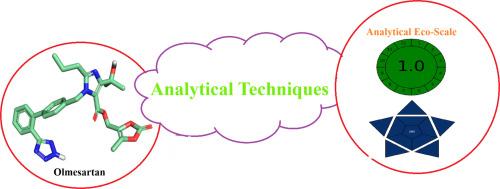对奥美沙坦-美多索密分析方法绿色计量工具评估的批判性回顾:案例研究
IF 3.2
引用次数: 0
摘要
绿色化学指标可以结合分析实践的特点,坚持绿色化学的原则。有几个指标可用于评估分析过程的环保性,包括AES、AGREE和BAGI。当前的综述文章概述了用于确定奥美沙坦案例研究的选定指标,采用各种分析技术,包括紫外分光光度法,HPLC, HPTLC, UPLC, LC-MS和UPLC- ms,基于特定标准。这些标准还包括每种技术的优点、缺点和局限性。分析生态尺度、AGREE值和BAGI值分别为79 ~ 86、72 ~ 84、66 ~ 68、77、75 ~ 89、67 ~ 75;0.6 - -0.71, 0.55 - -0.65, 0.58 - -0.65, 0.62, 0.65 - -0.66, 0.68 - -0.69;77.5 - -82.5, 72.5 - -82.5;紫外分光光度法、HPLC法、HPTLC法、UPLC法、LC-MS法和UPLC- ms法分别为75 ~ 77.5、80、75 ~ 80和80。结果是根据标准组织良好的,并产生了一个优秀的绿色方法。新的研究人员可以理解和使用所有的评估工具用于不同的目的。此外,他们可以利用它来开发新的程序,这可以展示一种更环保的方法来量化各种矩阵中的奥美沙坦。本文章由计算机程序翻译,如有差异,请以英文原文为准。

Critical review on the assessments of green metric tools for Olmesartan medoxomil analytical methods: Case studies
Green chemistry metrics can incorporate features of analytical practices that adhere to the principles of green chemistry. Several metrics are available to evaluate the greenness of the analytical procedure, including the AES, AGREE, and BAGI. The current review article outlines the selected metrics used to determine case studies of Olmesartan, employing various analytical techniques, including UV spectrophotometry, HPLC, HPTLC, UPLC, LC-MS, and UPLC-MS, based on specific criteria. These criteria also include the advantages, disadvantages, and limitations of each technique. The analytical eco–scale, AGREE and BAGI values were in the range 79–86, 72–84, 66–68, 77, 75–89, 67–75; 0.6–0.71, 0.55–0.65, 0.58–0.65, 0.62, 0.65–0.66, 0.68–0.69; 77.5–82.5, 72.5–82.5; 75–77.5, 80, 75 – 80 and 80 respectively for UV spectrophotometry, HPLC, HPTLC, UPLC, LC-MS and UPLC-MS. The results are well-organised according to the criteria and have produced an excellent greener methodology. The new researchers could understand and use all the assessment tools for different purposes. Additionally, they can utilise it to develop new procedures, which could demonstrate a greener methodology for quantifying Olmesartan in various matrices.
求助全文
通过发布文献求助,成功后即可免费获取论文全文。
去求助
来源期刊

Journal of chromatography open
Analytical Chemistry
CiteScore
2.50
自引率
0.00%
发文量
0
审稿时长
50 days
 求助内容:
求助内容: 应助结果提醒方式:
应助结果提醒方式:


